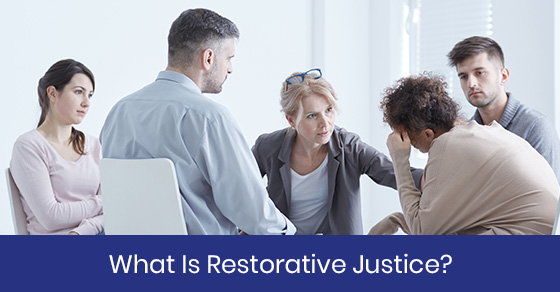What Is Restorative Justice?

Blog by Cassy Beaulac and Arun S. Maini
There are many ways to deal with crime and criminal behavior in modern society. Most involve two parties: the state and the defendant. The victim of an offence has historically been treated as somewhat of an afterthought; and even now, with the Victims’ Bill of Rights, and greater involvement of the victim in the criminal justice system, the role of the victim is limited, and can leave them feeling dissatisfied and frustrated with what to them seems like a closed-door process.
“Restorative justice” is a principled approach to addressing criminal behavior that is focused on crafting a meaningful solution that tackles both the harm caused to a victim while holding the wrongdoer accountable. The objective is to restore the interconnected relationship between the victim, wrongdoer and community. In a nutshell, restorative justice is motivated by repairing damage and restoring relationships between three stakeholders: the wrongdoer, victim and community.
The benefit to the victim is greater involvement in the process, and an opportunity to engage with the defendant directly.
The origins of the restorative justice approach find its roots in the small town of Elmira, Ontario in 1974. After two young men embarked on a vandalism spree, a forward-thinking probation officer and a prison support worker had the innovative and slightly rebellious idea at the time to ask the judge for permission for the two offenders to meet with the victim to see if reparations could be made, and the vandalism could be fixed. The judge agreed. The decades-old “Elmira Case” sparked the catalyst for a new school of thought based on the concepts of healing, responsibility and reconciliation when addressing wrongdoing.
From a restorative justice perspective on crime and criminal behaviour, a criminal offence is committed against a victim, and reparation is owed by the wrongdoer in order to make that that victim whole again, and restore the losses suffered by the crime.
Objectives of Restorative Justice
Restorative justice principles find their way in federal statues as well, such as the Youth Criminal Justice Act (“YCJA”), and the Criminal Code. For example, the sentencing regime enables restorative justice practices. Section 717 of the Criminal Code allows for restorative justice measures to be undertaken if the offender accepts responsibility for the offence committed. Similarly, section 718 of the Criminal Code outlines several principles of sentencing, including that sentencing should promote a sense of responsibility in the offender, and acknowledgement of the harm done to victims and the community, as well as provide reparations for the harm done to the victim and community.
The YCJA similarly contains provisions consistent with this approach, namely the focus on the underlying principles that govern youth sentences, conferences, and extrajudicial measures.
The Victims Bill of Rights and the Corrections and Conditional Release Act both provide that victims of crime in Canada have the right to receive information about restorative justice approaches if they request it.
Restorative justice helps those that commit harm understand the effects of their actions and behavior by helping them take responsibility for it. When wrongdoers are reintegrated back into their communities, and their relationships and ties to their communities are restored, the likelihood of recidivism is reduced. When community members are involved in the responding to crime and offering solutions, their voices, needs and wants are heard. Practically, restorative justice provides an alternative to a formal court process, and thus saves court time and expenses.
Benefits of Restorative Justice
Restorative justice can benefit the victim, wrongdoer and community holistically. When some victims are provided with the process to confront their wrongdoers to address the harm caused, they feel vindicated. Victims are further supported through their connections and ties to the community. Some victims (and families of victims) are provided solace when they benefit from understanding why their wrongdoer victimized them, and knowing that their wrongdoers acknowledge responsibility personally to them. Some victims find consolation that concrete steps are being undertaken by the wrongdoer to repair the harm committed against the victim and community.
Wrongdoers receive the benefit of seeing first-hand the harm their actions have caused to the victim and community. Sometimes the formal court process can distance and remove the victim entirely from the picture. The wrongdoer can benefit from apologizing to the victim, and taking steps to repair the harm committed. Underlying behavioral and social issues can also be addressed. For example, an alcohol-dependent wrongdoer who is transient can be provided with the opportunity to attend substance abuse counselling, and provided with housing security supports. Such community supports lowers the risk of recidivism because they address the underlying causes that motivated the criminal behavior.
Restorative justice is based on the recognition that those who victimize others live in and are part of a community, and it is important for that community to respond to crime to reduce it. When this occurs, community members are empowered because their voices are heard, and they become a stakeholder in criminal justice system. The community is generally in a better position to offer insight into the wrongdoer’s behavior, and what might be best to address the behavior. When programs focus on the reparation and prevention of crime (as opposed to solely punishment), the community feels safer. The public benefits from an accessible, less expansive out-of-court process.
With a restorative justice approach, the community has a better chance to see justice being done, and to feel included in the process. The chart below highlights some of the differences between the traditional two-party approach, and the more inclusive, community-based restorative justice approach.
Traditional Approach vs. Restorative Approach to Criminal Justice
| Traditional Approach | Restorative Approach |
|---|---|
| The government determines what the appropriate punishment should be. | A mutually-agreed upon solution by the wrongdoer, victim and community is determined. |
| The wrongdoer is held accountable through punishment, and this will repair the harm caused by crime. | The wrongdoer is held accountable by acknowledging responsibility, and working to repair the harm done to the victim and community. |
| Criminal behavior is a violation against the state. | Criminal behavior is a violation against the victim, and the community. |
| Justice is achieved for a victim through an adversarial, hierarchical criminal justice system that puts the wrongdoer up against the state. | Justice is achieved for a victim when the community, victim and wrongdoer engage in meaningful conversation to address the harm done, and how reparations can be made. |
| Crime occurs because it’s an individual act with individual responsibility. | Crime certainly has individual aspects, but also has social dimensions, such as housing instability, mental health, addictions and substance abuse, food insecurity etc. |
| Threats of punishment deter criminal behavior and punishment changes behavior. | Punishment alone does not change behavior, and it is disruptive to the relationships in the community. |
| The offenders should pay for“what the crime was worth.” | The offender is defined by their personal ability to make reparations. |
| The criminal justice system is adversarial in nature, and this means the offender should be pitted against the victim. | The victim is central to the process. The focus is on resolving the harm done, and moving forward, not solely on establishing guilt and blame. |
| The community is kept at a distance, represented by the Crown. The court system is inherently dependent on police, judges, lawyers etc. for resolution. | The community is a central participant, and facilitator of the restorative process. |
Restorative Justice is not Always Appropriate
- While restorative justice can and does benefit all parties in certain circumstances, it is not appropriate when:
- The offence committed by the wrongdoer is not relatively minor, statutorily not available, and/or seeks a mandatory custodial sentence.
- The wrongdoer does not take responsibility for their actions, and wishes to have a trial.
- The victim of the crime does not want to participate in restorative justice and wishes the wrongdoer to be sentenced conventionally.
- The wrongdoer’s community is so traumatized or victimized that it does not support the principles of restorative justice.
- Restorative justice is otherwise not within the wrongdoer’s best interests, and their legal rights are at risk of being jeopardized.
If you are facing criminal charges, and need the advice of an experienced and skilled lawyer to help you through the legal process and your options, including restorative justice, call The Defence Group for a free consultation at 877-295-2830.
CassyBeaulac is a recent graduate of the University of Windsor Law School
Arun S. Maini is a criminal lawyer and former prosecutor with 25 years of experience.


